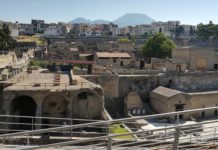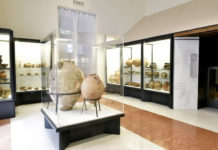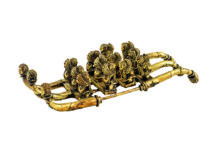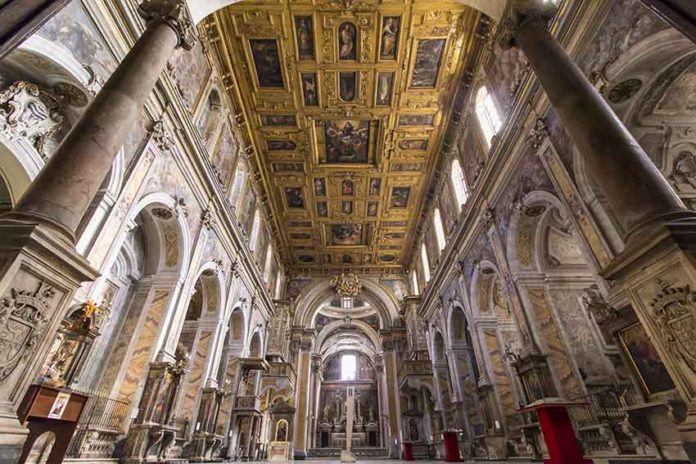
NEAPOLITAN MUSEUMS TO VISIT: SANTA MARIA LA NOVA. According to a suggestive and not yet proven theory, Vlad the Impaler died in Naples when he was a guest of his daughter, Maria. He was buried in the sepulcher of the Ferrillo family in the Franciscan citadel built at the end of the 13th century by the Friars Minor, on a plot of land donated by King Charles I of Anjou.
Dracula would, therefore, have died in Naples and his body would now be resting in one of the most evocative environments of the Monumental Complex of Santa Maria la Nova, the Franciscan citadel built in Naples at the end of the 13th century by the minor friars on a plot of land given to them by the king Charles I of Anjou and called “the Nova”, in order to distinguish it from Santa Maria from the Palatium, the monastery that once stood in the same place where, the Maschio Angioino was later raised.
The tomb of Vlad the Impaler, the dreaded prince of Wallachia, who inspired Bram Stoker’s imagination, is to be found just a few steps from Piazza Bovio and Piazza del Gesú, right on the edge of the historical center, which has been declared heritage of the humanity by UNESCO.
The Complex is an extraordinary monument which hosts masterpieces signed by the most famous Neapolitan painters of the late sixteenth and early seventeenth centuries. In Santa Maria La Nova, thanks to the guidance of the experts of the “Oltre il Chiostro Onlus” Association, presided by Giuseppe Reale, it is possible to revisit the history of the former capital of the Kingdom of the Two Sicilies.
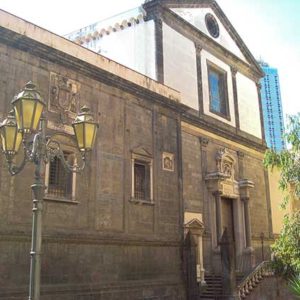
Faithful to the style imported to the South of Italy by the Angevin monarchs, the church and the adjoining convent of Santa Maria La Nova, originally had Gothic forms. Damaged by repeated earthquakes, the religious complex, which at the beginning of the sixteenth century, had acquired a new structure, that of the great chapel of San Giacomo della Marca (whose construction led to the demolition and modifications of various chapels) – went under a profound and revolutionary restyling work in 1596, that gave it its characteristic Baroque imprint. This restyling, respected the rigid canons of the Counter-Reformation, which still characterizes it today.
The church, with its austere Renaissance style facade, has a Latin cross plan and is equipped with a single tile-tiled nave and has a series of sparkling chapels which open wide along both its sides. It is accessed through a steep staircase in trachytic rock protected by a marble balustrade. The coffered ceiling, in gilded wood, is among the innumerable so-called “pearls” kept in the edifice. The ceiling is enriched by forty-six painted tables, which constitute a true anthology of pictorial art inspired by the last Neapolitan mannerism, before Caravaggio’s irruption on the European artistic scenes.
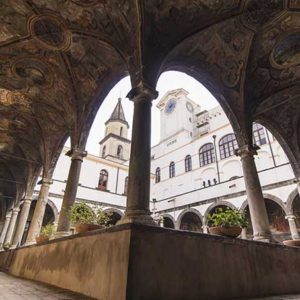
The adjacent convent – in which the upper rooms, once were the monks’ cells – is composed of a sacristy, a refectory and two extraordinary cloisters. Since 2008, the Oltre il Chiostro association has, here, set up the Museum of Contemporary Religious Art (Arca).
The cloister called “maggiore”, also known as the cloister of San Francesco, was ceded some time ago to the Province of Naples. It has lost most of its frescoes which once adorned its walls (depicting scenes from the life of Saint Francis of Assisi).
The “minor” cloister, also called the cloister of San Giacomo, houses a series of paintings with scenes from the life of San Giacomo della Marca, attributed to Andrea De Lione and a series of tombstones and sepulchral monuments. This is where the legend of Dracula’s tomb leads us. Here, where history enjoyed itself by interweaving its occult plots. According to a study, Dracula, in fact, rests right under the porticoes of the small cloister, in the sepulcher built in 1499 by the sculptor Jacopo della Pila, to house the mortal remains of Matteo Ferrillo. Some Italian scholars are convinced of the truth of this theory, also supported, in their thesis, by some colleagues from the Estonian University of Tallinn. Let’s jump back into time, in order to have a clearer picture.
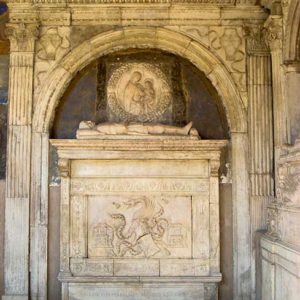
In 1476 Vlad III of Wallachia, who had recently regained the throne of his country, disappeared in battle while fighting against the Turks. Vlad, belonged to the order of the Dragon (“Dracula” from the Romanian “Dracul”, which literally means “son of the dragon”) just like the then king of Naples Ferrante D’Aragona. He was declared dead and one of his daughters, Maria Balsa, who at the time was only 7 years old, was adopted by a Neapolitan woman and then taken to Naples, perhaps because of the common “militancy” of the two kings, to escape the danger of an Ottoman invasion of Transylvania. Once become a woman, the girl married Matteo, a noble from the Neapolitan family of Ferrillo. According to a first version, she brought the mortal remains of her illustrious parent to the city of Naples and then buried them in the sepulcher of her husband. According to another version, Dracula did not die during the battle but was imprisoned by the Turks. Maria would have paid the ransom and then have him reach Italy. At his death, the former king of Wallachia would have been buried in the family tomb. So far the story. But there appears to be other elements that would confirm this thesis: the bas-reliefs carved on the sepulchral tomb of Dracula’s “son-in-law”.
A dragon with two symbols of Egyptian matrixes are carved on the tomb, which were never seen before, on a European tomb and which seem to recall some elements typical of medieval Slavic culture. These two opposing sphinxes recall the name of the city of Thebes, that the ancient Egyptians called “Tepes“. Those symbols seem to read “Dracula Tepes” which, incidentally, are also the two nicknames normally given to the prince.
Furthermore, just behind the tomb of the Ferrillo family, stands an enigmatic incision. A sort of “La Nova Code“, as it was renamed by the members of Oltre il Chiostro association, written in an unknown language. The only certain element so far deciphered, in this mysterious fresco (in which typical characters of the Latin, Coptic, Greek and Ethiopian alphabets have been identified), would seem to be the word “Vlad” that occurs several times. Vlad, like the name of the Count.
So far, the surprising coincidences of this story, appear to be no more that a novel. But, many historians do not believe this version of the story, because it is said that there is no concrete evidence of the permanence or burial of Vlad III in Italy or even of the existence of one of his daughters. And the reference itself to the city of Thebes is considered misleading since the epithet “Tepes”, normally flanked the name of Dracula, in Romanian means “pole”, therefore, “impaler”, which derives from the chilling torture that the “Vampire of Transylvania” was used to inflicting on his enemies. Doubts, perplexities and mysteries abound, together with signs and clues at will. In short, in the history of this monumental complex has everything to attract the attention of historians, art lovers and tourists. A monument that needs, care and maintenance, to the point that the Neapolitan association that manages it, has promoted the initiative “Restaura la Nova“, a collection of funds to be allocated to restoration (see video).
SANTA MARIA LA NOVA MONUMENTAL COMPLEX
MUSEUM OF CONTEMPORARY RELIGIOUS ART (ARCA)
Via Santa Maria la Nova, 44 – 80134 Naples
(near the University and Toledo stops, Line 1 of the Metropolitana
OPENING HOURS: Monday-Friday from 9.30 a.m. to 3.00 p.m. – Saturday and Sunday from 9.30 a.m. to 2.00 p.m.
CONTACTS: Tel. + 39 081 552 15 97 – Email: info@santamarialanova.info
web: www.santamarialanova.info

 Italiano
Italiano

